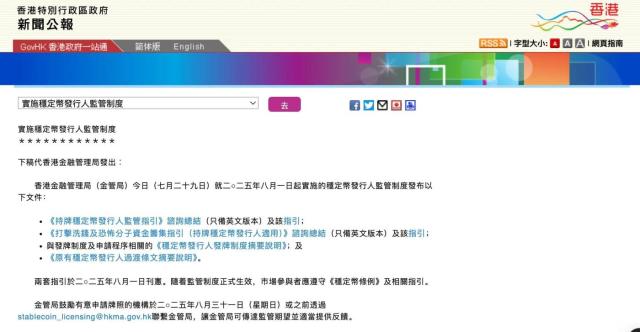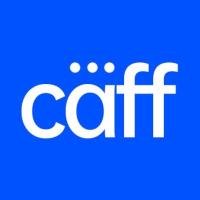Written by: Zhao Qirui, Lynne
"Hong Kong's established digital asset regulatory framework and its pioneering sandbox use cases clearly demonstrate how innovation can achieve robust development within a compliant framework. As stated in the Hong Kong Digital Asset Development Policy Statement 2.0, Hong Kong is continuously building a 'trustworthy and innovation-focused digital asset ecosystem' and will continue to consolidate its leading position in the global digital asset sector, driving Hong Kong's development into a global innovation hub."
【introduction】
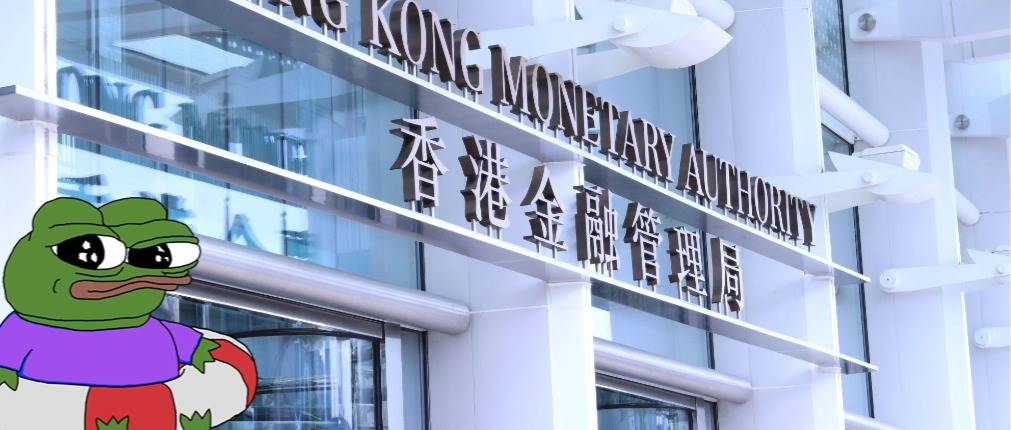
1. Development History of Digital Assets in Hong Kong
(I) Prelude: Mainland China’s “Pause Button” and the World’s “Fast Forward Button” (2017-2022)
In 2017, mainland China implemented a comprehensive shutdown policy on the virtual asset market, pressing the pause button on digital asset development. In September of that year, seven Chinese ministries and commissions jointly issued the "Announcement on Preventing Risks in Token Issuance and Financing," completely halting initial coin offerings (ICOs) and shutting down all domestic virtual currency trading platforms in an effort to effectively eliminate market risks. Since then, mainland China has further strengthened its crackdown on disguised and over-the-counter transactions, and in September 2021, it explicitly designated all virtual currency-related businesses (including trading, redemption, intermediary services, and advertising) as illegal financial activities. This series of high-pressure regulatory measures has effectively maintained the stability of the financial system and the controllability of risks.
However, this strict lockdown inadvertently became a catalyst for the global crypto industry, triggering a wave of talent, capital, and projects moving overseas. A large number of Web3 entrepreneurs, technical teams, and funds previously active in mainland China began seeking compliant development opportunities overseas, accelerating the global adoption and expansion of Web3 concepts.
While mainland China implements strict regulation, Hong Kong's role is more cautious and nuanced. It serves as both a "firewall" to prevent risk spillover and a quiet "observatory" for observing global Web3 developments. To protect investor interests while encouraging fintech innovation, the Hong Kong Monetary Authority (HKMA) pioneered the "Fintech Regulatory Sandbox" in September 2016. Subsequently, the Securities and Futures Commission (SFC) and the Insurance Authority (HKIA) each launched their own sandboxes, which were upgraded to "Sandbox 2.0" in 2017 to achieve cross-sector coordination. In September of the same year, the Securities and Futures Commission (SFC) of Hong Kong issued its first statement on ICOs, stating that if tokens possess "security" attributes, they may be regulated under the Securities and Futures Ordinance, emphasizing the regulatory principle of "substance over form." Since then, the SFC has continued to monitor the operations of virtual asset fund managers and trading platforms, and in 2018, it launched the Fintech Regulatory Sandbox, allowing companies to test their fintech projects, including those related to virtual assets, in a controlled environment.
At the application level, the Hong Kong government is actively exploring the practical applications of blockchain technology. For example, in 2020, it completed four blockchain pilot projects covering government services such as trademark transfers, environmental impact assessments, pharmaceutical product traceability, and company document archiving to explore the feasibility and benefits of blockchain technology. In June 2022, the government further launched a "Shared Blockchain Platform" and plans to develop more common services and reference program modules to assist various policy bureaux and departments in developing more blockchain applications.
Hong Kong is also actively exploring central bank digital currencies (CBDCs) and the tokenization of real-world assets (RWAs). The Hong Kong Monetary Authority (HKMA) launched the "Digital Hong Kong Dollar" research project in June 2021 and published the "Cryptoassets and Stablecoins Discussion Paper" in January 2022, proposing a regulatory framework for stablecoins. In 2021, the HKMA collaborated with the Hong Kong Center of the Bank for International Settlements Innovation Hub to complete "Project Genesis," a pilot program to test the issuance of tokenized green bonds in Hong Kong. In 2022, the Hong Kong government also participated in the NFT issuance pilot program at Hong Kong Fintech Week to test the technological benefits of virtual assets.
During this period, it's hard not to wonder why Hong Kong, which stands firmly with the Chinese people on the financial and economic fronts, has quietly been preparing and researching a regulatory framework for virtual assets while mainland China is tightening regulations. Despite a relatively slow start in terms of policy, its deep foundation as an international financial center, strong traditional financial industry foundation, and professional financial services capabilities have laid the foundation for more proactive development in the future.
(II) The Key to the Game: Hong Kong’s Moves and Strategic Intentions (2023-2025)
From late 2022 to 2023, Hong Kong's digital asset regulatory policy underwent a landmark shift, seen as a key move in the global digital economy's strategic chess game. On October 31, 2022, the Hong Kong SAR government issued the "Policy Statement on the Development of Virtual Assets in Hong Kong," explicitly proposing for the first time that it would "actively promote" the development of the virtual asset ecosystem, marking a shift in regulatory thinking from a "risk-oriented" to an "opportunity-oriented" approach. Subsequently, on December 7, 2022, the "Anti-Money Laundering and Counter-Terrorist Financing (Amendment) Bill 2022" was passed by the Hong Kong Legislative Council, formally establishing a mandatory licensing regime for virtual asset service providers (VASPs). This regime, effective June 1, 2023, allows licensed virtual asset trading platforms (VATPs) to provide services to retail investors while adhering to strict investor protection measures. Subsequently, Hong Kong further approved virtual asset spot ETFs, making it the largest virtual asset ETF market in the Asia-Pacific region. As of June 2025, the SFC had officially licensed 10 VATPs, with applications pending for another 11 institutions. In addition, the Hong Kong SAR government has also designated that the Stablecoin Ordinance will be officially implemented on August 1, 2025, further improving the regulatory framework for digital assets.
The decision to "open the door" at this time is interpreted by the author as a high-level strategic decision at the national level. After the global crypto market experienced a period of unbridled growth and risk exposure (such as the FTX and LUNA incidents), the market's demand for compliance, transparency, and trust has become more intense than ever. This is undoubtedly the perfect time for Hong Kong to serve as a "bridgehead," representing China in a compliant and controlled manner, to gather global digital asset resources, and to compete for a voice in the next generation of fintech. Hong Kong's unique "one country, two systems" framework enables it to balance its mission as an international financial center with mainland China's financial security concerns. Eddie Yue, Chief Executive of the Hong Kong Monetary Authority, noted that the ordinance establishes a "risk-based, pragmatic, and flexible regulatory environment" that provides healthy, responsible, and sustainable development for Hong Kong's stablecoin and broader digital asset ecosystem. Its goal is to significantly enhance the attractiveness of global Web3 talent, capital, and projects through a robust regulatory framework and ecosystem , empowering the real economy and providing new impetus for economic development. This will transform Hong Kong from a traditional international financial center into a leading global digital asset innovation hub, and consolidate its strategic position as a bridgehead for RMB internationalization and a "super connector." Hong Kong Financial Secretary Paul Chan Mo-po stressed that Hong Kong’s attitude towards Web 3.0 is not just about regulation, but about striking a balance to ensure market integrity without stifling innovation.
Hong Kong's "first-mover advantage" policy has also been actively embraced by mainland cities, foreshadowing the potential of a "Hong Kong pilot, mainland collaboration" model. For example, Ant Digital has designated Hong Kong as its overseas headquarters and successfully passed regulatory sandbox testing. Its RWA (Real World Asset) tokenization practices have proven successful, with examples like Longxin Group's collaboration with Ant Digital to complete China's first RWA project based on new energy physical assets, and GCL Energy's collaboration with Ant Digital to complete an RWA based on photovoltaic physical assets. Both projects were announced through the Hong Kong Monetary Authority's Ensemble Project Sandbox. These cases demonstrate that Hong Kong's regulatory clarity and international openness are providing a crucial channel for mainland companies to participate in the global digital asset market in a compliant manner. A report released by Zeng Shengjun of the Greater Bay Area Financial Research Institute of the Bank of China Shenzhen Branch and Guan Zhenqiu of the Bank of China Hong Kong Institute of Finance suggests that the experience of Hong Kong's stablecoin pilot program can be used to strengthen research on offshore RMB-linked stablecoins. In addition, the Hong Kong SAR government itself has played a leading role, for example, issuing NFTs in 2022, becoming the first region in China to issue tokenized government green bonds in 2023, and issuing the second batch of tokenized government green bonds in 2024. This strategic synergy not only promotes the development of Hong Kong's digital asset ecosystem, but also builds a new bridge connecting the mainland with international capital markets.
Long chart: Major events in Hong Kong from 2015 to August 2025

2. Hong Kong’s “Twin Peaks” Regulatory Framework for Digital Assets
Hong Kong's digital asset regulatory system is characterized by its "Twin Peaks" model. The Securities and Futures Commission (SFC) and the Hong Kong Monetary Authority (HKMA) work together to create a regulatory environment that encourages financial innovation while maintaining a strict risk-based environment. The essence of this model lies in a clear division of responsibilities: the SFC focuses on the "investment" attributes of virtual assets, while the HKMA focuses on their "payment" functions. The following table systematically explains the functions, legal basis, jurisdiction, and regulatory tone of the two regulatory bodies, providing a clear guide to understanding Hong Kong's regulatory landscape.
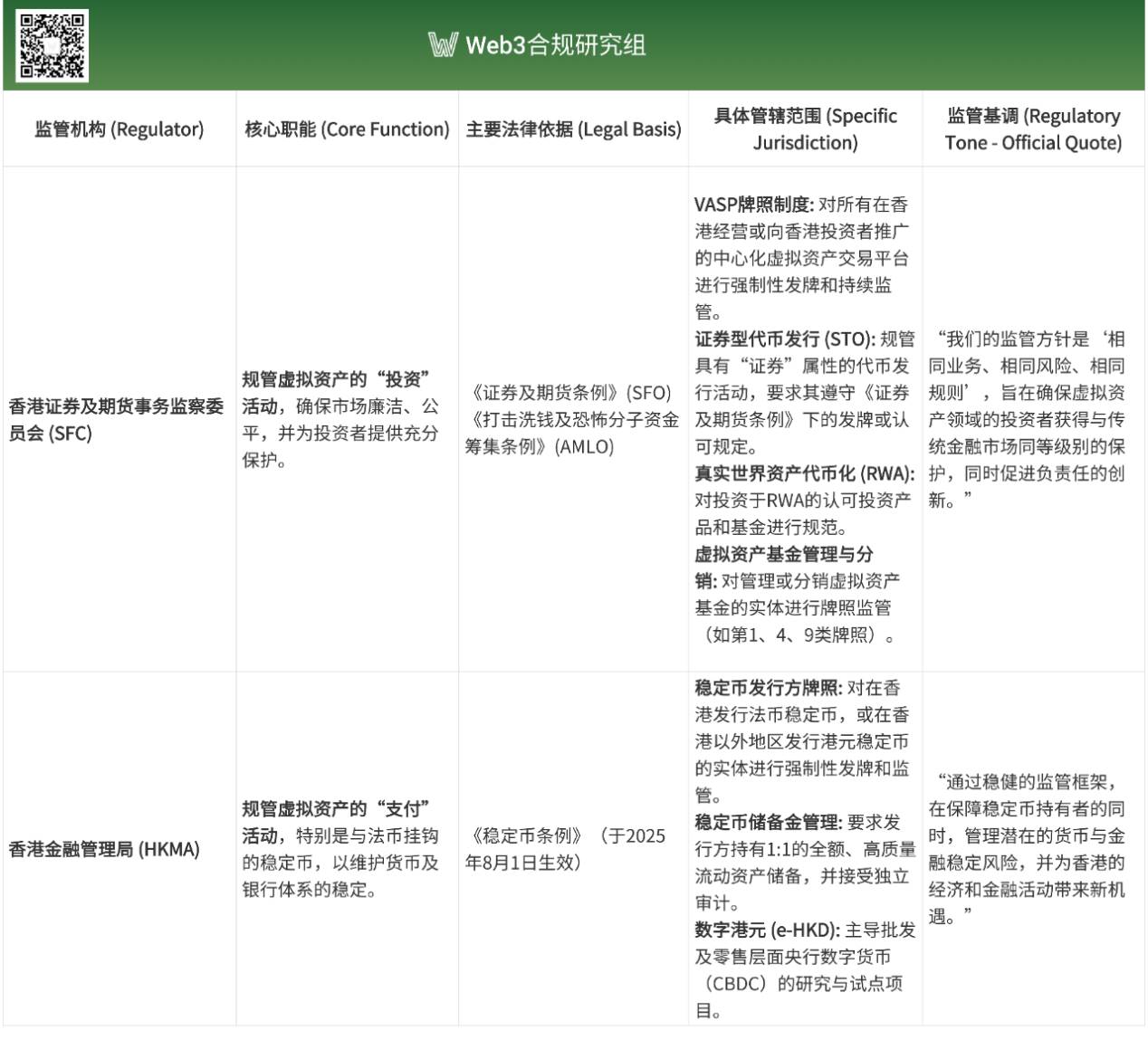
Table: Comparison of Powers and Responsibilities of Core Regulatory Agencies
Through a clear division of responsibilities and close collaboration (e.g., through the signing of a Memorandum of Understanding), the Hong Kong Securities and Futures Commission (SFC) and the Hong Kong Markets Authority (HKMA) have established a synergistic and complementary regulatory framework . As the guardian of the securities market, the SFC extends established investor protection principles to the virtual asset investment sector; while the HKMA, as the hub of the financial system, ensures that innovations in payment tokens do not undermine Hong Kong's monetary foundations. This dual-track approach, with clearly defined responsibilities and powers, provides a solid institutional foundation for Hong Kong's development into a leading global virtual asset hub.
III. Core Analysis of VASP Licenses and Stablecoin Issuance Regulation
Hong Kong's virtual asset regulatory framework is comprised of two core pillars: a licensing regime for virtual asset service providers (VASPs) and the regulation of stablecoin issuance. This section will delve into the key elements and regulatory logic of these two frameworks.
(1) VASP Licensing System: Setting Red Lines for Trading Platforms
The VASP licensing regime, effective June 1, 2023, is the core of Hong Kong's regulation of virtual asset trading. It mandates that all centralized virtual asset trading platforms (VATPs) operating in Hong Kong or serving Hong Kong investors, regardless of whether they trade security tokens, must be licensed. This initiative aims to bring all relevant platforms under a unified and rigorous regulatory framework.
1. Investor protection: informed, understanding, and affordable
To protect retail investors, regulators have established multiple thresholds. Before opening an account for a retail client, platforms must assess their knowledge of virtual assets and provide adequate risk disclosure. When recommending a trade, platforms must also ensure that the advice is appropriate for the client's individual circumstances. The underlying logic is clear: to ensure investors are "informed, understand the risks, and can afford them" before entering the market, thereby avoiding unnecessary losses due to information asymmetry. Furthermore, the CSRC reserves the power to impose investment caps on high-risk virtual assets, providing an additional layer of protection for retail investors' funds.
2. Customer asset security and financial stability
In light of the lessons learned from the collapse of platforms such as FTX due to misuse of customer funds, Hong Kong has set the world's top strict standards for customer asset security.
"Hard Segregation" of Assets : A core requirement is that platforms must place customers' virtual assets with an independent third-party custodian (typically a licensed Hong Kong trust company) and adhere to the industry best practice of 98% cold storage and 2% hot storage. This is intended to minimize the possibility of platform asset misappropriation. Customers' fiat currencies must also be held in a separate trust or designated account.
High financial thresholds : Platforms must not only have paid-in capital of at least HK$5 million and HK$3 million in liquid funds, but must also maintain sufficient liquid assets to cover at least 12 months of operating expenses. This ensures the platform's ability to withstand market risks and maintain continuous operations, preventing investors from being harmed by its own financial problems. Furthermore, platforms must purchase SFC-approved insurance for client assets.
3. Anti-Money Laundering/Countering the Financing of Terrorism (AML/CFT)
The anonymity and cross-border nature of virtual assets make them a hotbed for illicit activity. Therefore, VASP licenses require platforms to strictly implement AML/CFT measures, including Know Your Customer (KYC) and Customer Due Diligence (CDD). This includes continuous transaction monitoring, reporting of suspicious activity, and encouraging the use of blockchain analysis tools to enhance tracing capabilities. These regulations aim to enhance transaction transparency, combat financial crime, and safeguard Hong Kong's reputation as an international financial center and the integrity of its financial system.
4. Token Listing and Trading Scope
To mitigate risks at the source, platforms must establish independent token review committees. This committee is responsible for conducting rigorous due diligence on all proposed tokens, assessing their legality, security, team background, and even technical foundation. Regulations clearly stipulate that only highly liquid tokens that are non-securities and included in mainstream indices are available to retail investors. This prudent screening mechanism is designed to protect investors (especially retail investors) from low-quality or fraudulent projects, ensuring market fairness and transparency.
5. Prohibited Business Activities
To ensure platform neutrality, VATP is prohibited from engaging in proprietary trading for its own accounts. This is primarily intended to prevent conflicts of interest between the platform and its clients. Furthermore, current guidelines still prohibit platforms from issuing or trading virtual asset futures and related derivatives. This demonstrates the regulator's cautious approach to complex, high-risk products, prioritizing market stability. The China Securities Regulatory Commission (CSRC) has stated that it will review the possibility of opening such products to institutional investors at an appropriate time.
(II) Stablecoin Regulatory Framework: Setting Rules for “Quasi-Currency”
Stablecoin regulation is a key step in Hong Kong's efforts to become a global hub for virtual assets. Led by the Hong Kong Monetary Authority (HKMA), the relevant draft bill was passed on May 21, 2025, and will officially take effect on August 1 of the same year.
1. Focus on fiat-pegged stablecoins
The core target of the regulatory framework is "specified stablecoins" pegged to one or more fiat currencies, as these assets possess payment potential and their stability is directly linked to financial security. Based on the lessons learned from the Terra/LUNA collapse, algorithmic stablecoins lacking physical asset backing are explicitly excluded from regulation. Notably, this regulation has extraterritorial effect: regardless of the issuer's location, any Hong Kong dollar stablecoin issued by such a stablecoin that reaches Hong Kong users must comply with Hong Kong's licensing requirements.
2. Ensure the word "stability" is truly worthy of the name
To issue a stablecoin in Hong Kong, the issuer must obtain a license from the HKMA. The core requirements revolve around “stable” and “trustworthy”:
1:1 Full Reserve : 100% of the reserve must be backed by high-quality liquid assets.
Transparency and credibility : Reserves must be subject to regular third-party audits and disclosed to the public.
Robust operations : A reliable redemption mechanism, strict AML/CFT measures, and plans to ensure cybersecurity and business continuity must be in place.
These high threshold requirements are intended to ensure that stablecoins can be redeemed at any time, prevent the risk of "de-anchoring", and thus build market confidence.
3. Start cautiously and encourage innovation
HKMA will adopt an extremely cautious attitude in the initial issuance of licenses. It is expected that only a small number of licenses will be issued, and applicants will be required to prove that their stablecoins have clear and real application scenarios.
Hong Kong has established a "sandbox" mechanism to allow interested institutions to test their business models and risk management capabilities in a controlled environment. This "prudent licensing combined with sandbox piloting" strategy aims to ensure that the first batch of licensed institutions serve as benchmarks while providing valuable practical experience for regulators and the market. Ultimately, this will promote the compliant application of stablecoins in areas such as payments and cross-border remittances, solidifying Hong Kong's position as a leading financial innovator. In the following section, we will further analyze how this mechanism operates.
4. The Panoramic Process of the Regulatory Sandbox from the Applicant’s Perspective
Hong Kong's core strategy in virtual asset regulation is its meticulously designed "regulatory sandbox" mechanism. This is not only a regulatory tool but also a strategic platform for fostering the development of the fintech ecosystem, aiming to strike a balance between embracing fintech innovation and maintaining financial stability and investor protection. Essentially, Hong Kong's "regulatory sandbox" serves as a "dialogue mechanism between regulation and innovation" and a "testing ground for risk isolation."
This process is not just a simple license application, but a long, rigorous, and deeply interactive "co-evolution" journey that places extremely high demands on the applicant's capital, technology, compliance capabilities, and risk management skills.
To visualize this complex, multi-stage approval process, I've constructed the following "Regulatory Sandbox Panorama Flowchart." This chart, organized along timelines, details each key step, interaction model, and deliverable from initial conception to final license issuance, providing a clear roadmap for potential applicants.
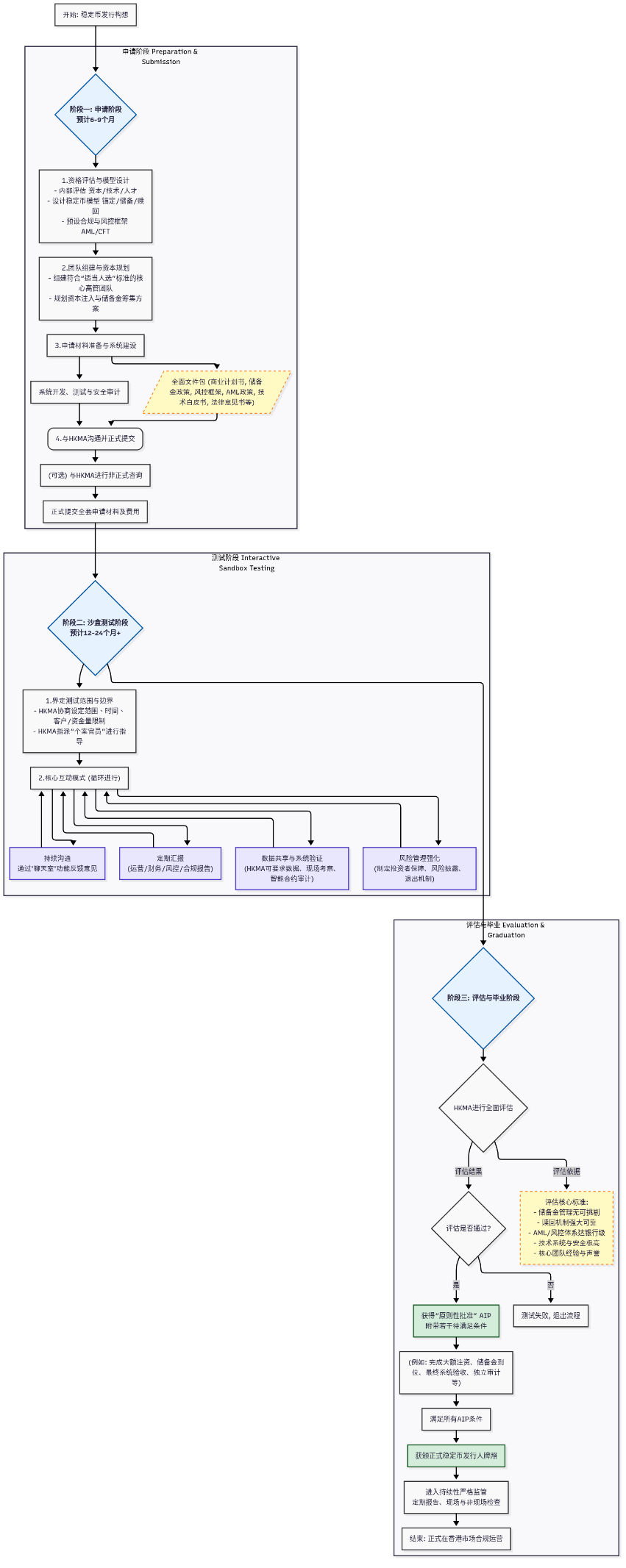
As can be seen from the above figure, the design of the entire process reflects the rigor, interactivity and penetration of Hong Kong's regulatory authorities.
1. Preparation is king (application phase): This phase focuses on internal refinement. The HKMA expects applicants to have completed a highly sophisticated business model design, technical system development, and compliance framework establishment before formal submission. This effectively front-loads the majority of preparatory work, ensuring that only well-prepared, high-quality participants enter the sandbox.
2. In-depth Interaction (Testing Phase): Far from a passive observation period, the sandbox serves as a "laboratory" where regulation and innovation collide and evolve together. By assigning "case officers," establishing a "chat room" mechanism, and requiring continuous data sharing and reporting, the HKMA is able to gain a deeper understanding of the actual operational risks of innovative businesses. Under regulatory guidance, businesses can then promptly adjust and optimize their plans, mitigating the risk of eventual non-compliance.
3. High-Standard Graduation (Assessment Phase): The "graduation" threshold is extremely high, with assessment criteria directly addressing the core of financial stability—reserve funds, redemption mechanisms, risk control systems, and technical security. The design, from "Approval in Principle (AIP)" to "Full License," provides a final safeguard for eventual market access, ensuring that all committed capital and systems are fully in place.
This rigorous process is more than just a regulatory checkpoint; it builds a mutually beneficial ecosystem for regulators and innovative companies. Its practical effects are two-way, as embodied in the following two aspects:
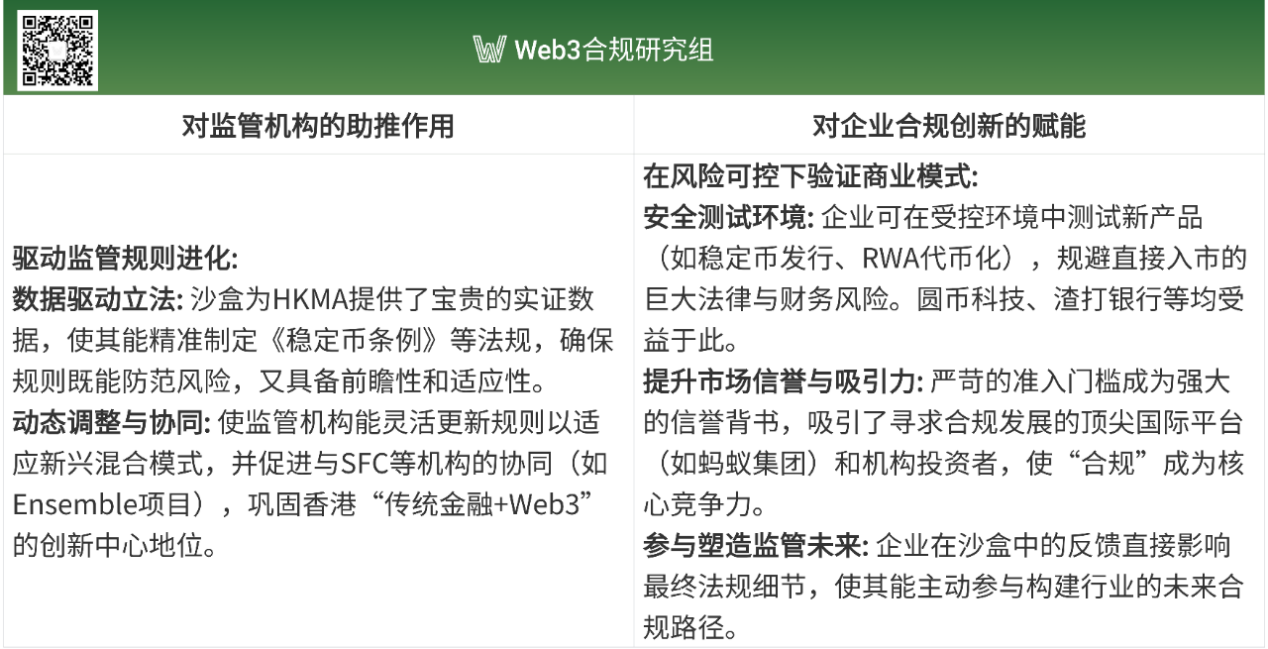
In summary, Hong Kong's regulatory sandbox mechanism, particularly the path designed for stablecoin issuers, is the most strategically visionary component of its digital asset regulatory framework. It transcends the traditional one-dimensional approval model and creatively integrates the seemingly opposing concepts of "strict regulation" and "cutting-edge innovation."
Through this meticulously designed process, Hong Kong has not only set world-leading compliance standards for the market but also established a dynamic, self-optimizing ecosystem of regulatory and industry interaction. This not only safeguards its own financial stability but also signals to the world that Hong Kong has the capability and wisdom to steer the future of digital finance and is committed to becoming the safest, most regulated, and most dynamic hub for the global virtual asset sector. This "two-way empowerment" sandbox is the cornerstone of Hong Kong's global leadership in digital finance. In Part Five of this article, we will delve into the sandbox to analyze this dynamic interaction.
V. Regulatory Sandbox: A Typical Case Study on the Path to Compliance
This chapter analyzes the practical cases of the regulatory sandbox in Hong Kong's digital asset field, reveals the core considerations from a regulatory perspective, and attempts to grasp the "development pulse" of Hong Kong in embracing web3 innovation.
(1) Stablecoin Regulatory Sandbox: Pragmatism First, Addressing Pain Points
In July 2023, the Hong Kong Monetary Authority (HKMA) launched a consultation on legislative proposals for implementing a regulatory regime for stablecoin issuers and announced the launch of a sandbox program. In July 2024, the HKMA announced the first batch of participants entering the sandbox, including JD CoinChain Technology (Hong Kong) , Yuanbi Technology , and a consortium consisting of Standard Chartered Bank (Hong Kong), Anmi Group, and HKT . All three companies plan to initially issue stablecoins pegged to the Hong Kong dollar.
JD CoinChain Technology (Hong Kong) : According to Liu Peng, CEO of JD CoinChain, its stablecoin project (JD-HKD) focuses on three practical use cases: cross-border payments, investment transactions , and retail payments . JD- HKD aims to expand its cross-border payment user base through direct and indirect customer acquisition (such as partnerships with compliant wholesalers), and to expand its investment and trading client base through collaborations with global compliant exchanges. For retail payments, the project will initially be launched on JD Global Shopping's Hong Kong and Macau sites, allowing users to pay bills using the stablecoin across JD's e-commerce businesses in Hong Kong and Macau. JD will develop tailored stablecoin payment solutions for different industries. Furthermore, JD will integrate its international logistics capabilities to store order and warehouse data for small and medium-sized enterprises (SMEs) operating overseas, improving their payment and financing efficiency. JD CoinChain has reportedly registered the names "JCOIN" and "JOYCOIN," and the market generally believes these two names will be used for its stablecoins.
Circle Coin Technology : Founded by Norman Chan, former Chief Executive of the Hong Kong Monetary Authority, Circle Coin Technology is about to launch the Hong Kong Dollar stablecoin (HKDR), targeting three key business scenarios: cross-border trade, virtual asset trading, and decentralized wallets (RWA ). Leveraging its parent company's stored value facility (SVF) license, and leveraging the foundation and channels established by shareholders and partners like HashKey Exchange, Cobo Digital Asset Custodian, and LianLian Pay in web3, custody, payment, and trading , Circle Coin Technology is poised to leverage its ecosystem synergies to establish a comprehensive web3 payment ecosystem, seamlessly connecting web2 and web3.
Standard Chartered Bank, Embraer Group, and HKT : Embraer Group, as a pioneer in the native web3 space, is responsible for developing native web3 application scenarios. Standard Chartered Bank, as the issuing bank of the Hong Kong dollar, leverages its banking client base. HKT, with its electronic payment app Tap&Go, focuses on reaching retail customers. Through this joint application, the three parties aim to maximize the promotion, scale, and application of stablecoins, reaching a full range of traditional banking and payment clients, as well as web3 users. Application scenarios include virtual asset trading in web3 games and cross-border trade and financial settlement in traditional finance.
Notably, on July 23rd, Eddie Yue, Chief Executive of the Hong Kong Monetary Authority, reiterated that many of the dozens of institutions he has approached with regarding stablecoin license applications lack practical application scenarios, concrete and feasible plans, and implementation plans, let alone the awareness and ability to manage risks. Some institutions that can offer application scenarios lack the technology to issue stablecoins and the experience and capabilities to manage financial risks. He recommended that these institutions not become issuers, but rather collaborate with issuers to provide application scenarios. Overall, the HKMA will only approve a few stablecoin licenses, which "may disappoint many applicants."
Based on the stablecoin issuers currently listed, the HKMA considers the following three key factors: First, it focuses on examining whether the issuer has real application scenarios , particularly in cross-border trade, e-commerce, finance, and other real economy service sectors, and whether it can leverage the advantages of stablecoin technology to improve payment efficiency and other financial conveniences in transactions. Second, it examines whether the issuer possesses the awareness and capabilities to manage financial risks and ensure the establishment of appropriate investor protection measures. Third, it controls the overall number of licenses issued to avoid the financial risks and waste of competitive resources caused by the lack of the first two prerequisites.
(II) Ensemble Sandbox: Innovating Financial Market Infrastructure and Promoting Tokenized Applications
In March 2024, the Hong Kong Monetary Authority (HKMA) announced the launch of Project Ensemble, a program to facilitate the use of wholesale central bank digital currencies (wCBDCs) for tokenized interbank deposit settlement and the use of tokenized currencies for tokenized asset trading . In May of the same year, the Project Ensemble Architecture Working Group was established to collaborate with the industry to develop standards and recommendations to promote interoperability among wCBDCs, tokenized currencies, and tokenized assets. In August, the HKMA announced the progress of the first phase of Project Ensemble and outlined four key tokenization use cases: fixed income and investment funds, liquidity management, green and sustainable finance, and trade and supply chain finance .
Fung-yee Leung, Chief Executive Officer of the Hong Kong Securities and Futures Commission (SFC), stated that Project Ensemble is a critical infrastructure project that will drive the scale and development of the tokenized ecosystem into the next phase of development and is the core of Hong Kong's innovative financial infrastructure. Tokenizing central bank currency and bank deposits at the wholesale level will inject significant momentum into the overall tokenization effort. Tokenizing currency and deposits is a prerequisite for fully realizing the potential of tokenization.
Over the past year, the Ensemble project has released many use cases, and this chapter will focus on some of them.
1. Green and sustainable finance
Ant Financial is a key participant in two key areas: green and sustainable finance, and trade and supply chain finance, and has implemented multiple use cases. In addition to the three use cases Ant Financial collaborated with, China Resources Land's "Charge Beautiful" electric vehicle charging station tokenization project was also selected for the Hong Kong Ensemble project, with a business model similar to Longsin Technology. This section will focus on these three use cases.
Charging Pile RWA (in partnership with Langxin Technology) : Langxin Technology is a leading energy technology company in China, having developed a variety of digital energy products and new energy internet platforms. For example, its utility payment platform, which partners with Alipay and other payment gateways , provides over 450 million metered users with online services for "inquiry, payment, billing, and receipts" for utility services like water, electricity, gas, and heating. The Xinyao Photovoltaic Cloud Platform , operating through a distributed photovoltaic platform, connects a wide range of power plants and aggregates surplus green electricity transactions for grid-connected power. Its new energy aggregation charging platform, Xindiantu , is building an AI-powered charging hub, connecting new energy vehicle demand with over 2 million charging devices. This demonstrates that Langxin is not a traditional new energy company leveraging digital technology for transformation, but rather an industry digital technology solutions provider with digital technology as its core competency, specifically a "technology and service provider specializing in business information systems in the utility sector."
This first RWA in the charging pile industry raised 100 million RMB. Langxin Group, using some of the charging piles operated on the Xindiantu platform as supporting assets, issued "charging pile" digital assets on the blockchain based on trusted data. Each digital asset represents a portion of the corresponding charging pile's revenue rights. Ant Chain's inside product module provides technical support for data on-chain. Local, small and medium-sized charging stations connected to Xindiantu face similar financing challenges as small and medium-sized enterprises, such as low creditworthiness and difficulty obtaining bank financing. However, they also have the advantages of familiarity with local resources, market development, and flexible operating models. By uploading equipment operation data to the blockchain, the project is expected to provide construction and operational support to thousands of small and medium-sized energy storage and charging pile operators on the platform, helping energy companies such as energy storage and charging operators to leverage their existing high-quality assets.
Photovoltaic Industry RWA (in collaboration with GCL Energy) : Ant Digital further collaborated with GCL Energy to successfully complete a RWA based on physical photovoltaic assets, involving over 200 million RMB. GCL Energy's "Xin Yangguang" brand, centered around residential photovoltaic business, offers a comprehensive business model encompassing product development, marketing, engineering, construction, and operational maintenance for residential photovoltaic systems. GCL Energy utilized approximately 82MW of "Xin Yangguang" residential photovoltaic projects in Hubei and Hunan provinces as supporting assets for the RWA. By integrating blockchain and IoT technologies, the project's value, operations, and revenue data were packaged and stored on the blockchain, generating digital tokens.
Two-Wheel Battery Swap (RWA) business (in partnership with the Cruise Eagle Group) : This initiative utilizes approximately 4,000 battery swap cabinets and 16,000 lithium batteries operated by Anhui Cruise Eagle New Energy Group nationwide as designated assets for a private placement, raising RMB 20 million. Combining IoT and blockchain technology, the project's value, operations, and revenue data will be stored on the blockchain, generating digital tokens. This will help revitalize existing assets, accelerate capital recovery, and enhance the liquidity and tradability of the battery swap assets.
The three new energy RWA cases we worked with Ant Financial show some commonalities:
First, compared with operating assets such as agricultural products, real estate, and restaurant operations that require human intervention, charging and swapping assets in the new energy industry have the inherent advantage of being connected to power and the network. They can operate autonomously and upload data without human intervention, eliminating the situation where some comments believe that "hiring a cleaning lady who costs 100,000 yuan a month to wipe the equipment" as an operating expense harms the interests of investors.
Secondly, compared with direct financing with large companies as the financing subject of the underlying assets, and indirect financing with large companies as the credit subject, RWA financing in the form of projects (the above cases are all the income rights of large-scale (millions) small and medium-sized new energy operating terminal equipment), provides a new solution to the financing of small and medium-sized enterprises (or a collection of small and medium-sized enterprises or operators), and provides support for overseas funds to support the development of the domestic new energy industry.
Third, Ant Financial provides a number of technologies to protect investor rights. For example, IoT technology ensures real-time asset connectivity and instant tracking of equipment operations, AI improves operational efficiency, and asset data is uploaded to the blockchain to ensure data authenticity and reliability. Ultimately, detailed data such as the new energy operator's charging device ID, charging device status, charging capacity, charging amount, and charging time are synchronized with multiple parties, providing transparent visibility of assets and returns.
The above cases provide new insights and inspiration for potential underlying assets in future RWA products . Existing assets with the following characteristics—networked management, local operations, access to power and internet, and direct revenue generation—have significant potential to become RWA-backed assets . Examples include locally shared rental equipment (such as self-service rental cars and scooters in shopping malls), smart unmanned retail kiosks, income rights from industrial equipment rentals, smart parking revenue rights, and income rights from leasing edge computing node computing services.
2. Trade and supply chain financing
Cross-border trade involves a multitude of international trade documents. A single transoceanic shipment may require 50 pages of documentation and involve 30 parties. As a crucial document of title, the ocean bill of lading ensures that goods are delivered to the consignee listed on the bill of lading. However, ocean bills of lading are still primarily circulated in traditional paper form, with electronic bills of lading accounting for less than 4% of all transactions in 2024. In 2018, COSCO Shipping initiated the establishment of the Global Shipping Business Network (GBSN). GBSN was incorporated in Hong Kong in 2021, and in July of the same year, it launched its first "paperless cargo release" product. In June 2022, the first blockchain-based electronic bill of lading based on the GSBN platform, the IQAX eBL, was approved by the International P&I Group.
Electronic Bill of Lading (eBL): Ant Digital assisted the HKMA in building a tokenized asset platform within the sandbox to facilitate delivery-versus-delivery (DvP) transactions between traditional assets and tokenized deposits. This platform allows tokenized trading of electronic bills of lading (eBLs) issued by the Global Shipping Business Network (GSBN). Ant Digital has also facilitated the use of tokenized deposits to settle eBL transfers with HSBC, Hang Seng Bank, and Bank of China (Hong Kong). This solution significantly improves trade process efficiency, enhances data and transaction security, and opens up new avenues to address trade finance gaps.
3. Fixed income and investment funds
Fixed income and investment funds focus on the tokenization of bonds and funds. In the bond market, Hong Kong has explored the tokenization of green bonds through EvergreenHub:
In February 2023, the Hong Kong SAR government announced the successful issuance of HK$800 million in tokenized green bonds under its Green Bond Programme, marking the world's first government-issued tokenized green bonds. The primary issuance of the bonds was conducted on a private blockchain network, using a T+1 delivery-versus-payment (DvP) settlement method between security tokens representing the actual bond interests and cash tokens representing the HKMA's Hong Kong dollar legal tender bonds. Settlement was provided by the HKMA's Central Moneymarkets Unit (CMU), with settlement handled by Goldman Sachs' tokenization platform, GS DAP™. Subsequent bond transactions (including coupon payments, secondary market settlement, and maturity redemption) were also conducted digitally on the private blockchain.
In February 2024, the Hong Kong SAR government announced the successful issuance of approximately HK$6 billion worth of digital green bonds denominated in Hong Kong dollars, RMB, US dollars, and euros under the Hong Kong Government Green Bond Programme. These digital green bonds, cleared and delivered using the CMU and HSBC Orion digital asset platforms, were among the world's first multi-currency digital bonds.
Traditional bond issuance or fund trading settlement processes typically take 2-5 business days. Tokenized bonds and funds support 24/7 timely payment and settlement, significantly reducing this time, streamlining the transaction process, eliminating settlement delays, and mitigating associated risks.
At the Ensemble Sandbox launch ceremony in August 2024, Hong Kong Monetary Authority Deputy Chief Executive Howard Lee stated that the bond issuance being tested in the sandbox aims to verify the end-to-end transaction process, which is technically different from previous tokenized bonds. The development of tokenized finance is not a one-time event, requiring verification at different technical levels. Therefore, it can be inferred that the initial issuance testing will focus on the issuance and settlement stages on blockchain networks and digital asset platforms. Later, the testing will focus on verifying the bond's circulation among a wider range of different entities, thereby validating the technologies required for 24/7 trading of tokenized green bonds.
HSBC and Bank of China (Hong Kong) are among the first participants in this initiative for money market funds . According to the two banks, they have already achieved the feasibility of tokenizing deposits and financial assets, trading between tokenized deposits and tokenized assets, and transferring deposit tokens to different financial institutions' blockchains.
This use case exemplifies how Ensemble facilitates the tokenization and trading of traditional financial assets between banks and aims to build new financial market infrastructure. The diagram below illustrates the process, with bold arrows indicating new technologies and trading channels being tested in the sandbox.
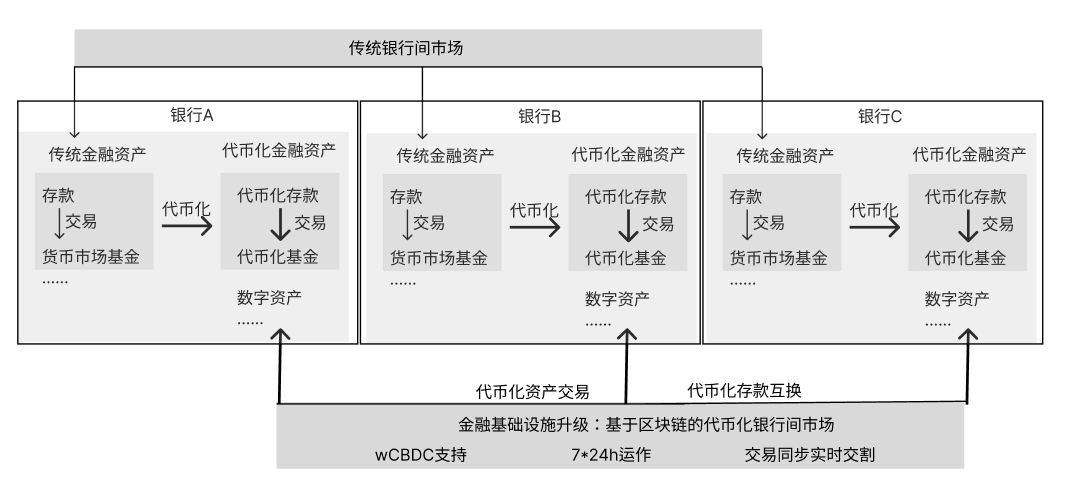
Figure: Ensemble Sandbox supports the tokenization of financial assets and the construction of new infrastructure
4. Liquidity Management
Liquidity management focuses on repurchase agreements and treasury management use cases, driving banks to build corporate treasury solutions based on tokenized deposits for their clients. In May 2025, HSBC launched its tokenized deposit infrastructure, launching Hong Kong's first bank-provided blockchain settlement service. Ant International was the first corporate client to adopt this solution. After tokenizing its subsidiary's deposits in HSBC accounts, Ant International issued a tokenized deposit transfer instruction to HSBC through its internal treasury platform, Whale, successfully completing an instant internal funds transfer. By leveraging the programmable and instantaneous settlement characteristics of tokenized deposits, tokenized treasury solutions are expected to provide more transparent, efficient, and convenient corporate payment and treasury management solutions.
VI. Future Outlook
Hong Kong's established digital asset regulatory framework, along with its pioneering sandbox use cases, clearly demonstrates how innovation can achieve robust development within a compliant framework. As stated in the "Hong Kong Digital Asset Development Policy Statement 2.0," Hong Kong is continuously building a "trustworthy and innovation-focused digital asset ecosystem," solidifying its leading position in the global digital asset sector and promoting its development as a global innovation hub.
With the official implementation of the Stablecoin Ordinance on August 1, it also provides a more solid institutional foundation and broad development space for Hong Kong to promote the application scenarios of stablecoins, expand the types of tokenized products, and enhance the liquidity and popularity of stablecoins and tokenized financial products.
Looking ahead, leveraging its deep roots as a traditional international financial center, its first-mover advantage in a systematic regulatory framework for digital assets, and its natural hub position connecting the mainland with the global digital asset market, Hong Kong is expected to become a key node for global digital assets and a core hub for the tokenization of real-world assets, thereby building unique and inimitable competitiveness.




